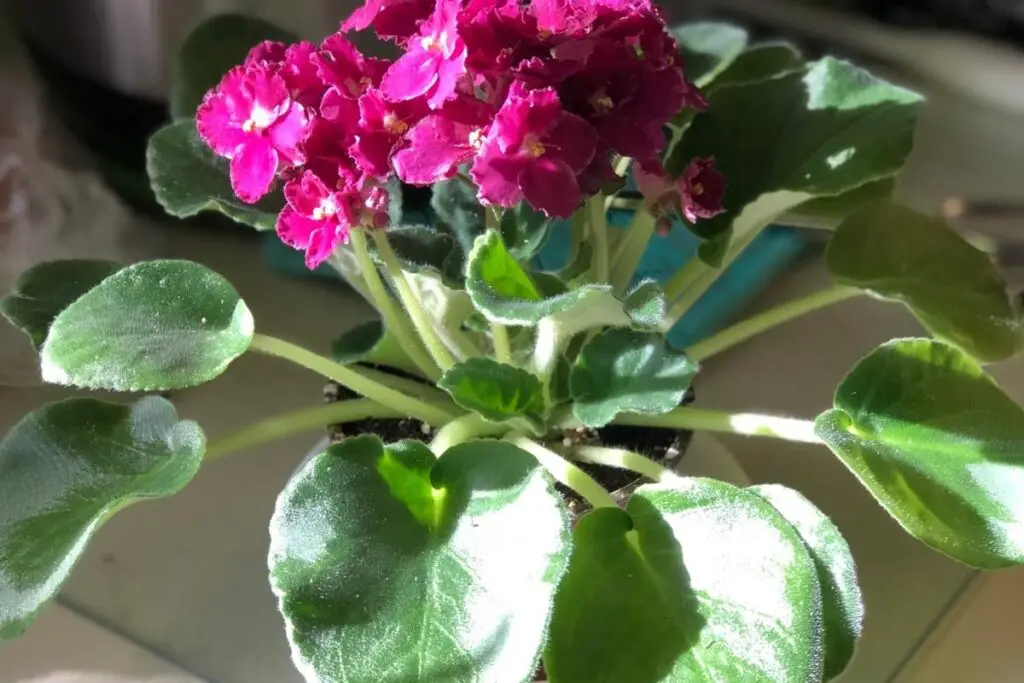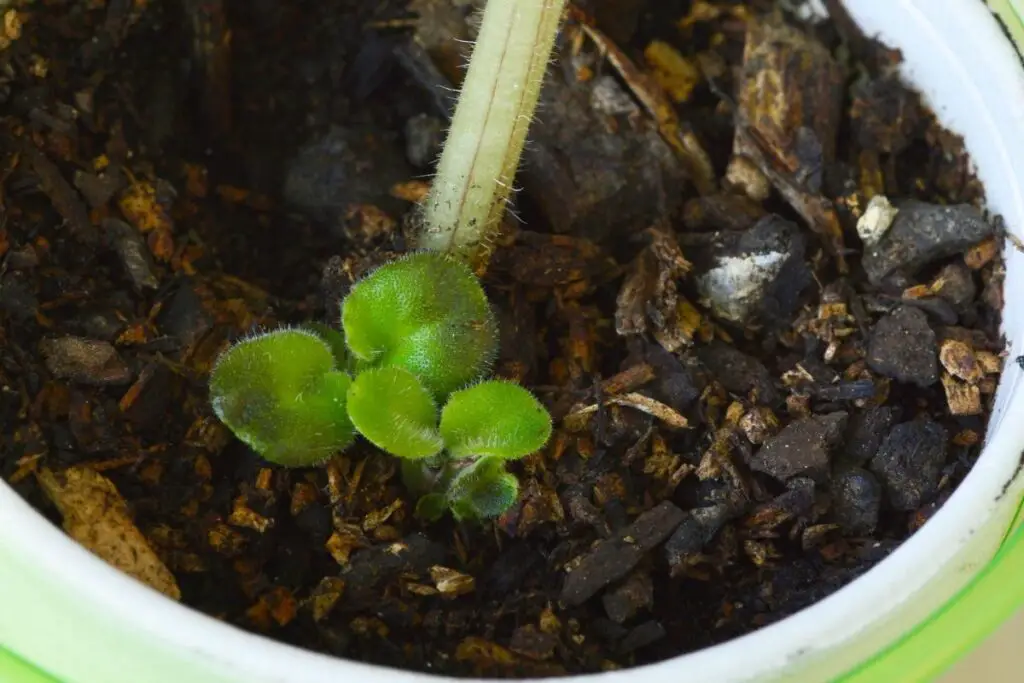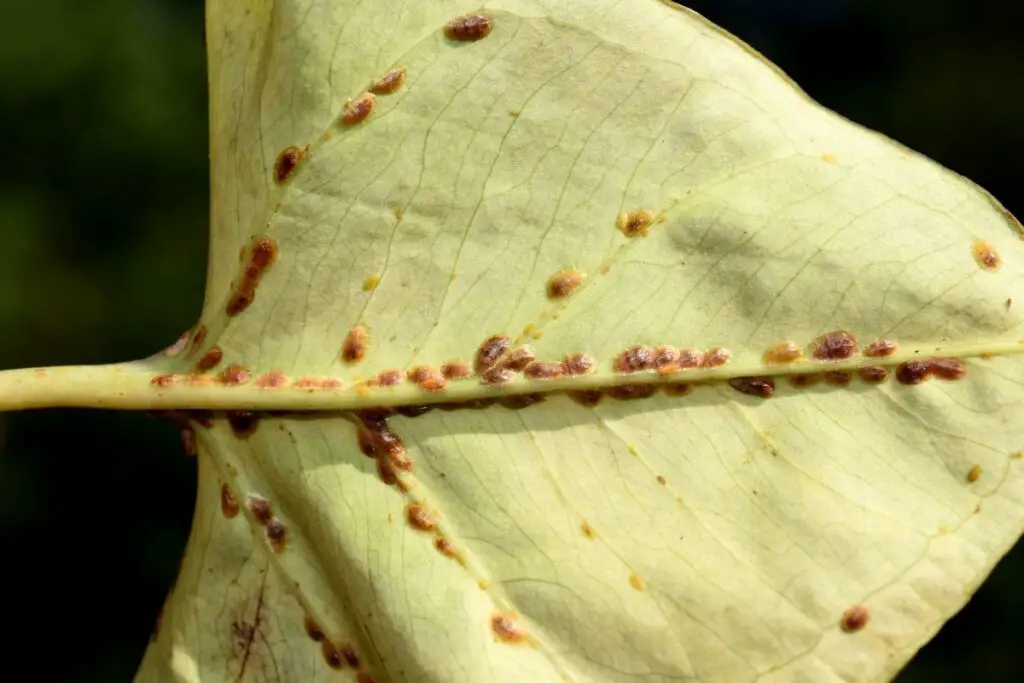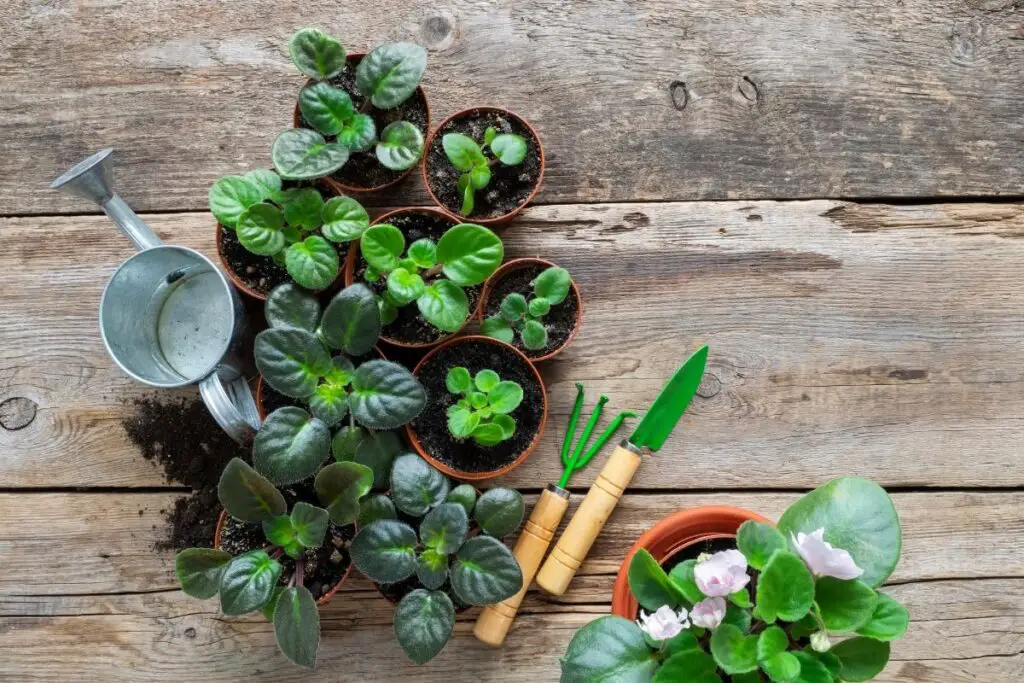African violets are grown in most homes and gardens because of their ability to bloom all year. However, it isn’t comforting to see the leaves of the beautiful flowers curling. Leaf curling is a sign that there is something wrong with your plant. You need to detect and treat the issue soon before the situation gets serious.
So, in this article, we will discuss why are the leaves on your african violet curling and how to fix the same.
African violet leaves start curling upward when kept at a low light spot, whereas leaves start curling inward when the plant receives too much light, too much water, or due to pests and diseases. Sometimes, too low temperature can also result in the curling of leaves in African violets.
But sometimes, curling is natural. Yes, you read that right.
This mostly depends on the variety of the plant you are growing. There is nothing to worry about in such a case. But before that, you need to ensure that everything else is fine.
So, in today’s article, I will explain all the possible reasons behind the curling of leaves in African violets. We will also cover the remedies of leaf curl.

Causes of curly leaves in African violets
Belonging to tropical East Africa, African violets are beautiful flowering plants with fuzzy leaves. Their needs can be fussy. Yet, they are low-maintenance plants.
Once you understand their standard requirements, you will not have a problem with maintenance.
Despite being low maintenance, you need to provide everything they need in the right amount. If you lack any one requirement, the plant will start reacting negatively. One of those is leaf curl.
The common causes of leaf curl in the African violets are:
- Improper lighting
- Dry soil
- Root rot
- Cold temperature
- Pest infestation
Now let us get into a detailed elaboration of the causes.
Improper lighting
African violets grow best under indirect sunlight. This is the reason they are mostly treated as houseplants. But, they can be grown outdoors if you provide them with the proper amount of light.
If the African violets get exposed to direct sun, they will react negatively by showing signs like downward curling, brown leaf edges, and sunburns.
Similarly, when they do not get enough sunlight, the leaves start curling upwards, and the plant becomes leggy because they are constantly trying to reach for the light. They need light for photosynthesis.
African violets need at least 8-12 hours of sunlight daily to survive.
How to fix it?
While growing the African violets outdoors, you need first select a suitable spot to plant the African violets. Choose a place with some tall trees around that can protect your African violets from the direct sun.
It is better to understand and know the directions of the sun so that the plant doesn’t get direct sun in the planting spot. African violets can tolerate direct sun during the early morning or late afternoons when the intensity is low.
Choosing a spot in the north or east will work well as these directions do not receive direct sun rays. To protect them from direct sun rays, you can create artificial shade for your plant bed.
For low light issues, you can fix artificial lights for your African violet bed. Make sure not to give them light continuously. African violets also need 8 hours of darkness to survive well.
Also read: What Kind Of Light Does An African Violet Need? (African Violet Light Requirements)
Looking for gardening supplies? We have tested 100's of products before recommending them to you guys. Check out our best pick below:
| Image | Gardening Supplies | Best Price? |
|---|---|---|
 Top
Top Top
Top | Raised Garden Bed Kit | Check On Amazon |
 | XLUX Soil Moisture Meter, Plant Water Monitor, Soil Hygrometer Sensor for Gardening, Farming, Indoor and Outdoor Plants, No Batteries Required | No Results |
 Top
Top Top
Top | 82 Pcs Garden Tools Set and Extra Succulent Tools Set | Check On Amazon |
 | Joeys Garden Expandable Garden Hose with 8 Function Hose Nozzle, Lightweight Anti-Kink Flexible Garden Hoses, Extra Strength Fabric with Double Latex Core, (50 FT, Black) | No Results |
 Top
Top Top
Top | Dual Chamber Compost Tumbler | Check On Amazon |
 Top
Top Top
Top | Sunnyglade Plant Stakes | Check On Amazon |
 Top
Top Top
Top | Organic Cold Pressed Neem Seed Oil | Check On Amazon |
 Top
Top Top
Top | Mighty Mint Gallon :-Insect and Pest Control Peppermint Oil | Check On Amazon |
 Top
Top Top
Top | Scotts DiseaseEx Lawn Fungicide | Check On Amazon |
 Top
Top Top
Top | Jacks Classic 20-20-20 All Purpose Fertilizer | Check On Amazon |
 Top
Top Top
Top | 30,000 Seeds Pollinator Attracting Wildflower Mixture | Check On Amazon |
 Top
Top Top
Top | Survival Vegetable Seeds Garden Kit-Over 16,000 Seeds | Check On Amazon |
Dry soil

If you see that the leaves of African violets are starting to curl upwards, it might be due to underwatering. You might have kept the soil too dry for an extended period.
African violets grow best when the topsoil is dry, but the lower part of the soil remains moist, not wet.
Another reason for dry soil might be that your soil has a high sand content in them. Sandy soil drains water very quickly. The plant does not get enough time to absorb the water and nutrients. Due to fast-draining, the soil dries up very quickly and remains like that.
How to fix it?
The first thing you need to make sure of is choosing suitable soil. While selecting a spot in the garden, avoid areas that have a high sand content. As I said earlier, sand drains water too fast.
You can use perlite, vermiculite, compost and peat moss with a ratio of 25:25:25:25 for making a perfect soil mix for the African violet bed. This will help retain enough moisture for the plants.
Maintain a proper watering schedule for the African violets. Water the plants according to seasonal needs. During the winter, you must water them less.
Make sure not to overwater it. To know when to water the plant, poke your finger into the soil bed. If the topsoil, about ½ inches, feels dry, then you need to water your plant.
Also read: How Often Should African Violets Be Watered? (African Violet Water Requirements)
Root rot
When the leaves of African violets start curling downwards, the reason is your plant might be suffering from root rot. This happens when your plant is overwatered for a long time.
Overwatering happens when the soil is not draining out the excess water or watering your plant continuously without checking the moisture level.
Curling leaves downwards are the early signs of root rot. When the situation becomes worse, the leaves start getting brown and then water-soaked. In severe conditions, you might get a foul smell from the soil bed.
How to fix it?
To save your plants from overwatering:
- Stop watering for one week.
- Allow the soil to drain the excess water before the next watering. After the topsoil dries, water again.
- Start small and increase gradually as per need.
Make sure that the soil does not have any clay content. Clay can hold water for an extended period. Watering it repeatedly will cause overwatering.
If there are any affected leaves, remove them. If you find signs of root rot, check it. Remove the affected brown roots.
Add some compost, vermiculite, or perlite to the soil. This will help in absorbing the moisture. These will also help in draining excess water from the soil.
If your African violets are undergoing severe root rot, you might have to transplant them to some other spot in your garden and avoid watering for some time.
Cold temperature
African violets prefer temperatures ranging between 65-75°F (18-24°C) during the day and 60°F (16°C) during the night.
Exposure to cold drafts is a common reason behind the leaf curls in African violets. Temperatures lower than the ideal range will make the leaves curl downwards.
When touched, these leaves will feel brittle. They become more fuzzy than usual.
Once you find such situations in the plant, you should solve the problem as soon as possible.
How to fix it?
In your garden, it is a difficult job to protect African violets from cold temperatures. But still, to some extent, you might be able to protect them.
Creating artificial shade will help to protect them from the cold, windy drafts blowing outside.
You can also arrange some grow lights inside if you have created dappled shades for the African violet flower bed. This will help create a warm temperature for the plant. It will also protect them from cold drafts.
Also read: African Violet Winter Care: Lighting, Watering, Fertilizing & More
Pest infestation

Pest infestation is another common reason behind leaf curl in the African violets.
It is sometimes difficult to identify the real reason behind leaf curl because both pest infestation and the effect of cold have the same leaf curl symptoms.
Whenever you find that the leaves are curling downwards, observe your plant closely. Check the leaves in the middle. Spider mites, mealybugs, aphids, and whiteflies are the common culprits.
These are all sap-sucking pests that suck out all the nutrients from the plant. In worse conditions, the plant starts changing its color and even dies.
How to fix it?
First, isolate the plant to stop the spread of the infestation to other plants. Also, remove the extremely affected leaves.
To eliminate the pests, you can handpick them if they are visible. They do not take much time to increase their colonies.
You can give your plant a good shower to remove a lot of pests. Keep the pressure under control without hurting the plant.
You can use some insecticidal soaps and neem oil to get rid of them.
Neem oil is very beneficial for your pest-infested plant. Spray some neem oil to your plant and let it remain like that. Keep applying until the problem is solved.
If the problem is severe, buy pesticides from the market and apply them to the plants. Before applying, read instructions carefully given in the labels of the product.
Also read: How To Get Rid Of Bugs On African Violets? (Signs+Treatment)
How to take care of a curling African violet?

Now that you understand all the reasons behind curling African violets, along with the remedies, let’s understand how to take care of a curling violet.
Situation 1: African violets have just started curling.
Once they start curling, first check for pests. If you find no pests, then something else is the reason.
Check whether they are receiving direct or intense sunlight. If your flower bed has a dappled shade, arrange and fix some lightweight curtains to create filters for direct sunlight. Along with that, keep a check on the moisture level of the soil.
If you give them all requirements adequately and still your plant is curling, then the surrounding environment is not suitable for them. Sometimes, sudden atmosphere change is the reason for curly leaves in the plant.
To cope up with the atmosphere change, water the plant well and allow it to settle down. Do not wet the soil too much. The plant will need some time to get adjusted to the recent change.
Situation 2: African violets curling due to poor watering technique.
If you keep neglecting, a poor watering technique causes overwatering, root rot, and even pest infestation.
To treat overwatering, you can stop watering for a week. During the early mornings, the sun rays are not intense like in afternoons.
So at that time, allow the plant to receive direct sunlight for some time. This will help the soil bed to dry up quickly.
If this doesn’t work, check the roots. If the roots have changed their color to dark brown and feel mushy, your plant has root rot.
The soil bed will also release a foul smell. You will have to transplant your African violets to some dry spot in your garden in such conditions.
How to transplant the African violets?
- Dig the ground carefully around the African violets using a shovel. Carefully loosen the roots with that shovel.
- Take out the affected plant carefully, without disturbing the root ball.
- Gently remove the old soil around the roots. Using a sterilized pruner, prune off the damaged brown roots carefully. Make sure you don’t harm the good ones.
- Select a suitable dry spot in your garden. Avoid clay and sandy areas of the garden.
- Dig a small hole of about ½ to 1 inch.
- Plant the violet into that hole and press the soil gently around the plant base. Don’t be too hard. Water little just to make the soil moist. Later you can gradually increase according to the plant’s need.
- If your plant has any spent flowers or leaves, prune them off before transplanting them.
- Choose a spot where they will receive indirect sunlight. A north or east direction will work fine as the sunlight is not that intense in those directions.
Natural curly leaves in African violets
Some African violets have natural curly leaves. It depends on which variety of African violet you are growing. There are few African violets whose leaves have a natural curl, which is completely healthy.
Before you grow them, you need to know about their variety. If the curl is natural, then curly leaves are not something you should worry about.
Because leaf curling is a problem in an African violet, it is better to understand it properly before accepting it.
If you try fixing your plant issue without any real issue, it would be just a waste of your energy.
Final words
Keep observing your African violets daily to determine the issues.
Use sanitizers or disinfectants to clean the areas around your plant after dealing with pests and fungus.
Make sure to avoid overwatering and under-watering. You can maintain a calendar to mark out the dates of watering. That might help you in maintaining a proper watering schedule.
Always protect them from high and low temperatures. As they are popular houseplants, growing them outdoors can be challenging. So, take care of them with extra attention.
Provide them with all their requirements, and they will please you with their beautiful flowers year-round.
Source: Wikipedia, African violet: Classical breeding, African Violet Society of America, In vitro propagation of African violet, University of Florida, North Dakota State University, The University of Georgia.
